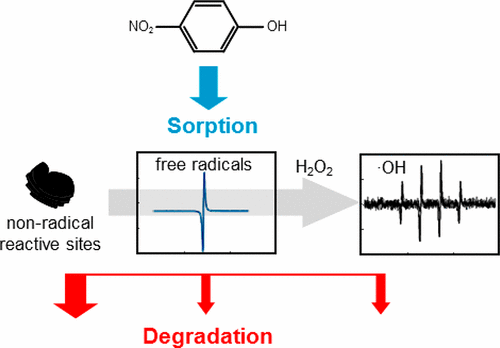当前位置:
X-MOL 学术
›
Environ. Sci. Technol.
›
论文详情
Our official English website, www.x-mol.net, welcomes your
feedback! (Note: you will need to create a separate account there.)
Degradation of p-Nitrophenol by Lignin and Cellulose Chars: H2O2-Mediated Reaction and Direct Reaction with the Char
Environmental Science & Technology ( IF 10.8 ) Pub Date : 2017-07-25 00:00:00 , DOI: 10.1021/acs.est.7b01087 Jing Yang 1, 2 , Joseph J. Pignatello 3 , Bo Pan 1 , Baoshan Xing 2
Environmental Science & Technology ( IF 10.8 ) Pub Date : 2017-07-25 00:00:00 , DOI: 10.1021/acs.est.7b01087 Jing Yang 1, 2 , Joseph J. Pignatello 3 , Bo Pan 1 , Baoshan Xing 2
Affiliation

|
Chars and other black carbons are reactive toward certain compounds. Such reactivity has been attributed to reduction of O2 by persistent free radicals in the solid to H2O2, which then back-reacts with the solid to generate reactive oxygen species (ROS; especially HO•). We studied the decomposition of p-nitrophenol (PNP) by pure lignin and cellulose chars aged in moist air or a vacuum at room temperature for up to a month. In air, the chars chemisorbed oxygen, a portion of which was liberated as H2O2 when the char was submerged in water. The evolved H2O2 was simultaneously decomposed by the char. PNP reacted predominantly in the sorbed state and only reduction products (phenol, catechol) were identified. Aging the char in air sharply (within hours) reduced H2O2-producing capacity and free radical concentration, but more gradually reduced PNP decay rate over the month-long period. PNP decay was only modestly suppressed (12–30%) by H2O2 removal (catalase), and had little effect on the free radical signal (<6 radicals annihilated per 1000 PNP reacted). Contrasting with previous studies, the results show that direct reaction of PNP with char predominates over H2O2-dependent reactions, and the vast majority of direct-reacting sites are nonradical in character. Nonradical sites are also responsible in part for H2O2 decomposition; in fact, H2O2 pretreatment depleted PNP reactive sites. Lignin char was generally more reactive than cellulose char. The Fe impurity in lignin played no role. The results are relevant to the fate of pollutants in black carbon-rich environments and the use of carbons in remediation.
中文翻译:

木质素和纤维素焦炭降解对硝基苯酚:H 2 O 2介导的反应以及与焦炭的直接反应
炭和其他黑碳对某些化合物具有反应性。这种反应性归因于固体中的持久性自由基将O 2还原为H 2 O 2,然后该H 2 O 2与固体发生反反应以生成活性氧(ROS;尤其是HO •)。我们研究了纯木质素和纤维素焦炭在潮湿空气或真空中于室温下老化长达一个月所产生的对硝基苯酚(PNP)的分解。炭在空气中化学吸附了氧气,当炭浸在水中时,一部分氧气以H 2 O 2的形式释放出来。析出的H 2 O 2被炭同时分解。PNP主要在吸附状态下反应,仅鉴定到还原产物(苯酚,邻苯二酚)。空气中的焦炭急剧老化(数小时内)会降低H 2 O 2的生产能力和自由基浓度,但在一个月的时间内会逐渐降低PNP的衰减速率。H 2 O 2的去除(过氧化氢酶)仅适度地抑制了PNP的衰减(12-30%),并且对自由基信号的影响很小(每1000个PNP反应消灭了少于6个自由基)。与以前的研究相反,结果表明,PNP与炭的直接反应比H 2 O 2更为重要。依赖的反应,以及绝大多数直接反应位点都是非自由基的。非自由基位点还部分负责H 2 O 2的分解。实际上,H 2 O 2预处理消耗了PNP反应位。木质素炭通常比纤维素炭更具反应性。木质素中的铁杂质没有作用。该结果与富含黑碳的环境中污染物的命运以及碳在补救中的使用有关。
更新日期:2017-07-26
中文翻译:

木质素和纤维素焦炭降解对硝基苯酚:H 2 O 2介导的反应以及与焦炭的直接反应
炭和其他黑碳对某些化合物具有反应性。这种反应性归因于固体中的持久性自由基将O 2还原为H 2 O 2,然后该H 2 O 2与固体发生反反应以生成活性氧(ROS;尤其是HO •)。我们研究了纯木质素和纤维素焦炭在潮湿空气或真空中于室温下老化长达一个月所产生的对硝基苯酚(PNP)的分解。炭在空气中化学吸附了氧气,当炭浸在水中时,一部分氧气以H 2 O 2的形式释放出来。析出的H 2 O 2被炭同时分解。PNP主要在吸附状态下反应,仅鉴定到还原产物(苯酚,邻苯二酚)。空气中的焦炭急剧老化(数小时内)会降低H 2 O 2的生产能力和自由基浓度,但在一个月的时间内会逐渐降低PNP的衰减速率。H 2 O 2的去除(过氧化氢酶)仅适度地抑制了PNP的衰减(12-30%),并且对自由基信号的影响很小(每1000个PNP反应消灭了少于6个自由基)。与以前的研究相反,结果表明,PNP与炭的直接反应比H 2 O 2更为重要。依赖的反应,以及绝大多数直接反应位点都是非自由基的。非自由基位点还部分负责H 2 O 2的分解。实际上,H 2 O 2预处理消耗了PNP反应位。木质素炭通常比纤维素炭更具反应性。木质素中的铁杂质没有作用。该结果与富含黑碳的环境中污染物的命运以及碳在补救中的使用有关。

































 京公网安备 11010802027423号
京公网安备 11010802027423号